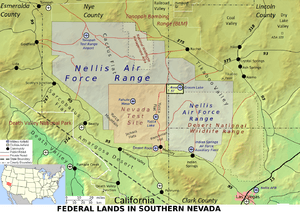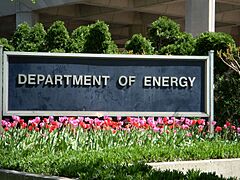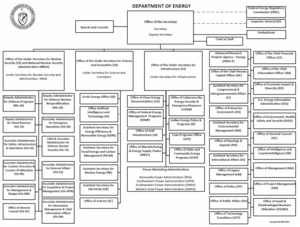United States Department of Energy facts for kids

Seal of the U.S. Department of Energy
|
|
 James V. Forrestal Building, headquarter building named after James Forrestal |
|
| Agency overview | |
|---|---|
| Formed | August 4, 1977 |
| Preceding agencies |
|
| Jurisdiction | U.S. federal government |
| Headquarters | James V. Forrestal Building 1000 Independence Avenue Southwest, Washington, D.C., U.S. 38°53′13″N 77°1′34″W / 38.88694°N 77.02611°W |
| Employees | 14,382 federal civilian (2018) 93,094 contract (2008) |
| Annual budget | $45.7 billion (2023) |
| Agency executives |
|
| Key document |
|
The United States Department of Energy (DOE) is a part of the U.S. federal government. It helps manage the country's energy. The DOE works on many important things. These include creating energy plans, producing energy, and researching nuclear power. It also handles the military's nuclear weapons program. The DOE helps make nuclear reactors for the United States Navy. Plus, it supports research related to energy and promotes energy conservation.
The DOE was started in 1977. This happened after the 1973 oil crisis when there were problems with oil supply. The DOE supports more science research than any other U.S. government agency. Much of this research happens at its National Laboratories. The DOE also leads research in genomics, like the Human Genome Project.
The head of the department is the Secretary of Energy. This person reports directly to the president of the United States. The Secretary is also a member of the President's Cabinet. The current Secretary of Energy is Chris Wright. He started in this role in February 2025. The main office of the DOE is in Washington, D.C.. It is located in the James V. Forrestal Building. There are also other offices in Germantown, Maryland.
Contents
How the Department of Energy Started
Early Beginnings and Growth
In 1942, during World War II, the U.S. Army started the Manhattan Project. This project was created to develop the atomic bomb. After the war, in 1946, the Atomic Energy Commission (AEC) was formed. Its job was to control the future of atomic energy. The Atomic Energy Act of 1946 also set up the first National Laboratories. The AEC worked on many nuclear projects. For example, it made uranium fuel cores.
Later, in 1974, the Energy Reorganization Act of 1974 changed things. It split the AEC's duties into two new groups. The Nuclear Regulatory Commission was created to oversee the nuclear power industry. The Energy Research and Development Administration (ERDA) was given the job of managing nuclear weapons and energy development.
Creating the Department of Energy
The 1973 oil crisis showed that the U.S. needed a clear energy plan. In 1977, President Jimmy Carter signed a law called the Department of Energy Organization Act. This law officially created the Department of Energy. The new agency began its work on October 1, 1977. It brought together several older agencies and programs. These included the Federal Energy Administration and the ERDA. James Schlesinger, who had been Secretary of Defense, became the first Secretary of Energy.
President Carter wanted the DOE to help save energy. He also wanted it to find new energy sources. This would reduce the country's reliance on fossil fuels. Energy was a big issue at the time. The oil crisis caused shortages and inflation. The DOE helped President Carter deal with energy challenges. For example, it helped make changes to the Nuclear Regulatory Commission. This improved how nuclear energy and weapons were managed.
Loan Programs and Partnerships
In 2001, the DOE helped sponsor the American Solar Challenge. This was a race for solar-powered cars.
A law passed in 2005, the Energy Policy Act of 2005, allowed the DOE to offer loan guarantees. These guarantees help projects that reduce air pollution or greenhouse gases. They support new or much-improved technologies. A loan guarantee means the DOE promises to help repay a loan if the project meets certain conditions.
In September 2008, the DOE teamed up with other groups. They created the World Institute for Nuclear Security (WINS). This group helps share ideas on how to keep nuclear and radioactive materials safe.
In December 2024, the DOE's Loan Programs Office announced a very large loan. It was a $15 billion loan to Pacific Gas & Electric. This money will help modernize their hydroelectric power system. It will also improve power lines for renewable energy and electric vehicles.
How the Department of Energy is Organized
The Department of Energy changed its organization in 2022. It now has new names for some of its leaders.
| Program | |
|---|---|
| Secretary of Energy | Deputy Secretary of Energy *Associate Deputy Secretary of Energy |
| Assistant Secretary of Energy (International Affairs) | |
| Assistant Secretary of Energy (Congressional and Intergovernmental Affairs) | |
| Office of the General Counsel | |
| Office of the Chief Financial Officer | |
| Advanced Research Projects Agency-Energy | |
| Energy Information Administration | |
| Federal Energy Regulatory Commission | |
| Enterprise Assessments | |
| Energy Policy and System Analysis | |
| Intelligence and Counterintelligence | |
| Public Affairs | |
| Office of Management | |
| Office of Project Management | |
| Chief Human Capital Officer | |
| Chief Information Officer | |
| Economic Impact and Diversity | |
| Hearings and Appeals | |
| Assistant Secretary of Energy (Environmental Management) *Legacy Management |
|
| Small and Disadvantaged Business Utilization | |
| Under Secretary for Science and Innovation | Arctic Energy Office |
| Office of Critical and Emerging Technologies (CET) | |
| Assistant Secretary of Energy (Energy Efficiency and Renewable Energy) | |
| Assistant Secretary of Energy (Electricity) | |
| Assistant Secretary of Energy (Fossil Energy and Carbon Management) | |
| Assistant Secretary of Energy (Nuclear Energy) | |
| Office of Science | |
| Under Secretary of Energy for Nuclear Security | National Nuclear Security Administration |
| Under Secretary for Infrastructure | National Laboratory Operations Board |
| Associate Under Secretary of Energy (Environment, Health, Safety and Security) | |
| Office of Clean Energy Demonstrations | |
| Office of Federal Energy Management Programs | |
| Grid Deployment Office | |
| Office of Cybersecurity, Energy Security, & Energy Response | |
| Indian Energy Policy and Programs | |
| Loan Programs Office | |
| Office of State and Community Energy Programs | |
| Bonneville Power Administration | |
| Southeastern Power Administration | |
| Southwestern Power Administration | |
| Western Area Power Administration | |
The DOE is led by the United States Secretary of Energy. This person is chosen by the President of the United States. The Secretary gets help from the United States Deputy Secretary of Energy. This Deputy Secretary also takes over if the Secretary is away. The department also has three Under Secretaries. They each manage a main part of the DOE's work. There are also seven Assistant Secretaries. They are in charge of different parts of the department.
What the DOE Seal Means
The official seal of the Department of Energy has special meanings. It has a green shield with a gold lightning bolt. On the shield, you can see a sun, an atom, an oil derrick, a windmill, and a dynamo. Above the shield is a white eagle head on a white rope. All of this is on a blue background. The name of the agency is written in gold on a green circle around the edge.
The eagle shows the careful planning needed to meet the country's energy needs. The sun, atom, oil derrick, windmill, and dynamo represent different energy technologies. The rope shows how these technologies work together for our future. The lightning bolt stands for the powerful natural forces that give us energy. It also shows the challenge of using these forces.
The colors in the seal come from nature. They represent where energy comes from and how it supports life. Blue stands for air and water. Green represents mineral resources and the earth. Gold shows the creation of energy from natural forces. These colors mean that the country wants to meet its energy needs while protecting the natural environment.
DOE Research and Development Locations
The Department of Energy runs many national laboratories and technical places. These facilities are used for research and development.
- Ames National Laboratory
- Argonne National Laboratory
- Brookhaven National Laboratory
- Fermi National Accelerator Laboratory
- Idaho National Laboratory
- Lawrence Berkeley National Laboratory
- Lawrence Livermore National Laboratory
- Los Alamos National Laboratory
- National Energy Technology Laboratory
- National Renewable Energy Laboratory
- Oak Ridge National Laboratory
- Pacific Northwest National Laboratory
- Princeton Plasma Physics Laboratory
- Sandia National Laboratories (SNL)
- Savannah River National Laboratory
- DOE/SNL Scaled Wind Farm Technology (SWiFT) Facility
- SLAC National Accelerator Laboratory
- Thomas Jefferson National Accelerator Facility
- Albany Research Center
- Bettis Atomic Power Laboratory – designs nuclear power for the U.S. Navy
- Kansas City National Security Campus
- Knolls Atomic Power Laboratory – designs nuclear power for the U.S. Navy
- National Petroleum Technology Office
- Nevada National Security Site
- New Brunswick Laboratory
- Office of Fossil Energy
- Office of River Protection
- Pantex Plant
- Radiological and Environmental Sciences Laboratory
- Savannah River Site—different from Savannah River National Laboratory
- Y-12 National Security Complex
- Yucca Mountain nuclear waste repository
Other important DOE facilities include:
Airstrip:
- Pahute Mesa Airstrip – in Nye County, Nevada, part of Nevada National Security Site
Nuclear Weapons Sites

The DOE, through its NNSA, is in charge of designing, testing, and making all nuclear weapons. The NNSA works with contractors at these government-owned sites:
- Research and Design: Los Alamos National Laboratory and Lawrence Livermore National Laboratory
- Non-Nuclear Parts: Sandia National Laboratories works on the engineering of parts that are not nuclear and puts systems together.
- Key Components: The Kansas City Plant, Savannah River Site, and Y-12 National Security Complex make important parts.
- Testing: The Nevada Test Site is where tests happen.
- Assembly and Taking Apart: Pantex is where weapons are put together and taken apart.
Laws Related to Energy

Many laws have shaped how the U.S. manages energy. Here are some key ones:
- 1920 – Federal Power Act
- 1935 – Public Utility Holding Company Act of 1935
- 1946 – Atomic Energy Act (created the Atomic Energy Commission)
- 1954 – Atomic Energy Act of 1954, as Amended
- 1956 – Colorado River Storage Project
- 1957 – Atomic Energy Commission Acquisition of Property
- 1957 – Price-Anderson Nuclear Industries Indemnity Act
- 1968 – Natural Gas Pipeline Safety Act
- 1973 – Mineral Leasing Act Amendments (for the Trans-Alaska Oil Pipeline)
- 1974 – Energy Reorganization Act (split the AEC into two new agencies)
- 1975 – Energy Policy and Conservation Act
- 1977 – Department of Energy Organization Act (created the Department of Energy)
- 1978 – National Energy Act
- 1980 – Energy Security Act
- 1989 – Natural Gas Wellhead Decontrol Act
- 1992 – Energy Policy Act of 1992
- 2000 – National Nuclear Security Administration Act
- 2005 – Energy Policy Act of 2005
- 2007 – Energy Independence and Security Act of 2007
- 2008 – Food, Conservation, and Energy Act of 2008
DOE Funding and Spending
In May 2009, President Barack Obama asked for $26.4 billion for the DOE's budget for 2010. This included $2.3 billion for the DOE's Office of Energy Efficiency and Renewable Energy (EERE). This budget aimed to use more renewable energy sources. It also wanted to improve how energy is sent across the country. It planned to invest a lot in hybrid and plug-in hybrid cars. It also focused on smart grid technologies and science research.
As part of a $789 billion economic help package in 2009, Congress gave the DOE an extra $38.3 billion. This was for 2009 and 2010. It added about 75 percent to the DOE's yearly budgets. Most of this money was given as grants and contracts. For 2013, here's how the DOE's main parts spent their money:
| Division | Funding (in billions) |
|---|---|
| Nuclear Security | $11.5 |
| Energy and Environment | $9.5 |
| Science | $4.9 |
| Management | $0.25 |
| Other | $0.85 |
| Total | $28 |
In March 2018, Energy Secretary Rick Perry talked about the budget request for 2019. This budget focused on nuclear security. It also made big cuts to programs for energy efficiency and renewable energy. The proposal was a $500 million increase from 2017. It aimed to create a new Office of Cybersecurity, Energy Security, and Emergency Response (CESER). It also planned to strengthen the National Nuclear Security Administration. However, the budget for the Office of Energy Efficiency and Renewable Energy was lowered. It went from $1.3 billion in 2017 to $696 million in the plan. Overall, the department's energy programs were cut by $1.9 billion.
DOE Programs and Projects
Energy Savings Contracts
Energy Savings Performance Contracts (ESPCs) are special agreements. A company designs and builds an energy-saving project. They also get the money needed for it. The government agency then pays the company over time. These payments come from the money saved on utility bills. The company promises that the energy improvements will save money. After the contract ends, all the savings go to the government agency.
Energy Innovation Hubs
Energy Innovation Hubs are places where many different experts work together. They aim to develop new energy science and technology. They take ideas from early research to a point where they are ready for companies to use. The Consortium for Advanced Simulation of Light Water Reactors (CASL) was the first such hub. It started in July 2010. Its goal was to create better computer models for nuclear reactors.
The 2009 DOE budget included $280 million for eight Energy Innovation Hubs. Each hub focuses on a specific energy challenge. Two hubs work on making buildings more energy-efficient. They use smart materials and designs. Another two hubs focus on new ways to store energy. They also work on making fuels directly from sunlight. One more hub develops "smart" materials for the electrical grid. These materials help the grid adapt to changes.
In 2012, the DOE gave $120 million to the Ames Laboratory. This money was to start a new hub called the Critical Materials Institute. This institute works on improving the supply of rare earth elements.
Advanced Research Projects Agency-Energy (ARPA-E)
ARPA-E was officially created in 2007. It is part of the United States Department of Energy. It did not have a budget at first. Its first budget of about $400 million came from an economic stimulus bill in February 2009.
Other Important Programs
- DOE Isotope Program - helps make isotopes for science and medicine.
- Federal Energy Management Program - helps government agencies save energy.
- Foundation for Energy Security and Innovation - supports DOE research.
- Fusion Energy Sciences - researches nuclear fusion, which could be a clean energy source.
- GovEnergy - an annual event partly sponsored by the DOE.
- Grid Deployment Office - helps spread new technologies for the power grid.
- Indian Energy Policy and Programs - supports energy projects in Native American communities.
- National Science Bowl - a science competition for middle and high school students.
- Solar Decathlon - a competition where college teams design and build solar-powered houses.
- State Energy Program - helps states develop their energy plans.
- Weatherization Assistance Program - helps low-income families make their homes more energy-efficient.
Leaders of the Department of Energy
The table below lists the people who have served as the Secretary of Energy.
| # | Name | Term | President served | |
|---|---|---|---|---|
| Start | End | |||
| 1 | James R. Schlesinger | August 6, 1977 | August 23, 1979 | Jimmy Carter |
| 2 | Charles W. Duncan, Jr. | August 24, 1979 | January 20, 1981 | |
| 3 | James B. Edwards | January 23, 1981 | November 5, 1982 | Ronald Reagan |
| 4 | Donald Paul Hodel | November 5, 1982 | February 7, 1985 | |
| 5 | John S. Herrington | February 7, 1985 | January 20, 1989 | |
| 6 | James D. Watkins | March 1, 1989 | January 20, 1993 | George H. W. Bush |
| 7 | Hazel R. O'Leary | January 22, 1993 | January 20, 1997 | Bill Clinton |
| 8 | Federico F. Peña | March 12, 1997 | June 30, 1998 | |
| 9 | Bill Richardson | August 18, 1998 | January 20, 2001 | |
| 10 | Spencer Abraham | January 22, 2001 | January 31, 2005 | George W. Bush |
| 11 | Samuel W. Bodman | February 1, 2005 | January 20, 2009 | |
| 12 | Steven Chu | January 21, 2009 | April 22, 2013 | Barack Obama |
| 13 | Ernest Moniz | May 16, 2013 | January 20, 2017 | |
| 14 | Rick Perry | March 2, 2017 | December 1, 2019 | Donald Trump |
| 15 | Dan Brouillette | December 4, 2019 | January 20, 2021 | |
| 16 | Jennifer Granholm | February 25, 2021 | January 20, 2025 | Joe Biden |
| 17 | Chris Wright | February 4, 2025 | Incumbent | Donald Trump |
See also
 In Spanish: Departamento de Energía de los Estados Unidos para niños
In Spanish: Departamento de Energía de los Estados Unidos para niños
- Federal Energy Regulatory Commission
- National Council on Electricity Policy
- United States federal executive departments


